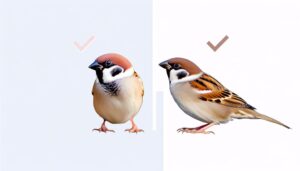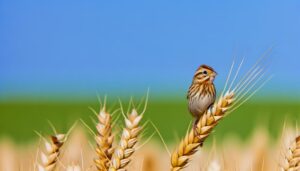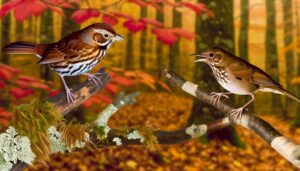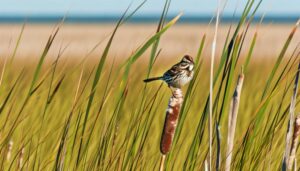How to Identify Common Sparrows in Ohio
Ohio hosts several distinct sparrow species, contributing to its lively biodiversity. The common species include the chipping sparrow, field sparrow, and the song sparrow with its remarkably melodious tune.
The American tree sparrow, adaptable to Ohio's cold winters, also calls the Buckeye State home. The fox sparrow and swamp sparrow likewise offer diversity to Ohio's ecosystems.
As diligent seed dispersers and an important food source for predators, sparrows play a key role in maintaining Ohio's ecological balance. Learning more about these hardworking birds will reveal how to attract them to your garden.

Key Takeaways
- Ohio is home to several sparrow species including Chipping Sparrow, Field Sparrow, American Tree Sparrow, White-Throated Sparrow, Fox Sparrow, Swamp Sparrow, and Song Sparrow.
- The Song Sparrow, known for its complex, melodious song, has streaked brown underparts, a dark spot on the chest, and is common in Ohio's gardens, fields, and wetlands.
- The American Tree Sparrow, identifiable by its rusty cap and eyeline, bi-colored bill, and smaller size, thrives in Ohio's cold climate.
- Sparrows play a vital role in Ohio's ecosystem as diligent seed dispersers, a significant food source for predators, and their high reproduction rate ensures population sustainability.
- Attracting sparrows to your garden in Ohio can be done by providing ample food sources, safe nesting spots, fresh water, planting native Ohio plants, and installing birdhouses with small entrances.
Identifying Ohio's Sparrow Species
In Ohio, one can identify at least seven distinct sparrow species, each exhibiting unique features and behaviors that set them apart from the others.
The Chipping Sparrow, for example, bears a crisp, clean chest and a distinct rufous cap, while the Field Sparrow sports a pink bill against its light grey face.
The American Tree Sparrow, another common sight, is defined by its bi-colored bill and a single dark spot on its unstreaked breast.
The White-Throated Sparrow, on the other hand, is easily distinguishable by its striking white throat against a backdrop of black and white head stripes.
The Fox Sparrow's thick streaks of rust and the Swamp Sparrow's gray face contrasted by its rust-colored wings are also telltale signs.
Observing these subtle variations in plumage and markings allows for accurate identification.
Song Sparrow: The Melodious Bird
Boasting a complex and melodious song, the Song Sparrow is a distinctive member of Ohio's avian community, characterized by its streaked underparts, long, rounded tail, and a dark spot on its chest. It's a common sight in gardens, fields, and wetlands across the state.
For a deeper understanding, let's consider the table below:
| Feature | Description | Significance |
|---|---|---|
| Song | Complex, melodious | Used for attracting mates and defending territory |
| Underparts | Streaked brown | Provides camouflage in varied habitats |
| Tail | Long, rounded | Aids in flight and balance |
| Chest Spot | Dark, central | Key identification feature |
These characteristics not only assist the bird in survival but also make it a fascinating subject for birdwatchers. Its song, in particular, provides a harmonious soundtrack to Ohio's natural landscapes.
American Tree Sparrow's Unique Traits
Moving from the melodious Song Sparrow, let's now shift our focus to the American Tree Sparrow, a bird recognized for its unique traits and adaptability to Ohio's chilly winters. This bird, scientifically named Spizelloides arborea, has a distinctive rusty cap and eyeline, contrasting its grey chest and white belly. They're smaller than most sparrows, with a length of about 5.5 inches.
Unique to this species is its bi-colored bill, with the upper part dark and the lower part yellow. Adaptability is key for survival, and the Tree Sparrow thrives in Ohio's cold climate. It's able to metabolize food quickly for energy to withstand frigid temperatures.
The American Tree Sparrow's distinct features and resilience make it a fascinating species in Ohio's avian biodiversity.
Sparrows' Role in Ohio's Ecosystem
Sparrows play a vital role in Ohio's ecosystem, serving as both diligent seed dispersers and a significant food source for various predators. Their consistent foraging habits aid in the distribution of seeds across diverse geographical areas, promoting plant growth and biodiversity. This necessary task fosters the health of local flora, aiding in the propagation of various plant species.
Additionally, sparrows serve as a viable food source for numerous predators, such as hawks, snakes, and cats. This predator-prey relationship contributes to the natural balance within Ohio's ecosystem. Sparrows' high reproduction rate guarantees their population's sustainability, despite predation pressures.
In essence, sparrows' role in Ohio's ecosystem is vital. They're not just birds; they're unsung heroes maintaining the delicate ecological equilibrium.
Attracting Sparrows to Your Garden
Often, you can attract sparrows to your garden by implementing specific measures, such as providing ample food sources, safe nesting spots, and fresh water. The key is to replicate their natural habitat.
Sparrows primarily feed on seeds, berries, and insects, so consider planting native Ohio plants that produce these. Nesting can be encouraged by installing birdhouses, preferably with a small entrance to ward off predators.
Fresh, clean water is essential, not just for drinking, but also for bathing. A shallow birdbath will suffice. Birds are sensitive to chemicals, so avoid using pesticides in your garden.
Conclusion
Just as a symphony needs each instrument, Ohio's ecosystem thrives with the presence of sparrows. These birds, like the Song Sparrow with its enchanting melody, or the distinctive American Tree Sparrow, act as nature's pest controllers.
Attracting these feathered guests to your garden isn't just a hobby; it's a small step towards maintaining Ohio's ecological balance. Remember, even the seemingly insignificant sparrow plays a vital role, akin to a single note in a grand orchestral piece.






